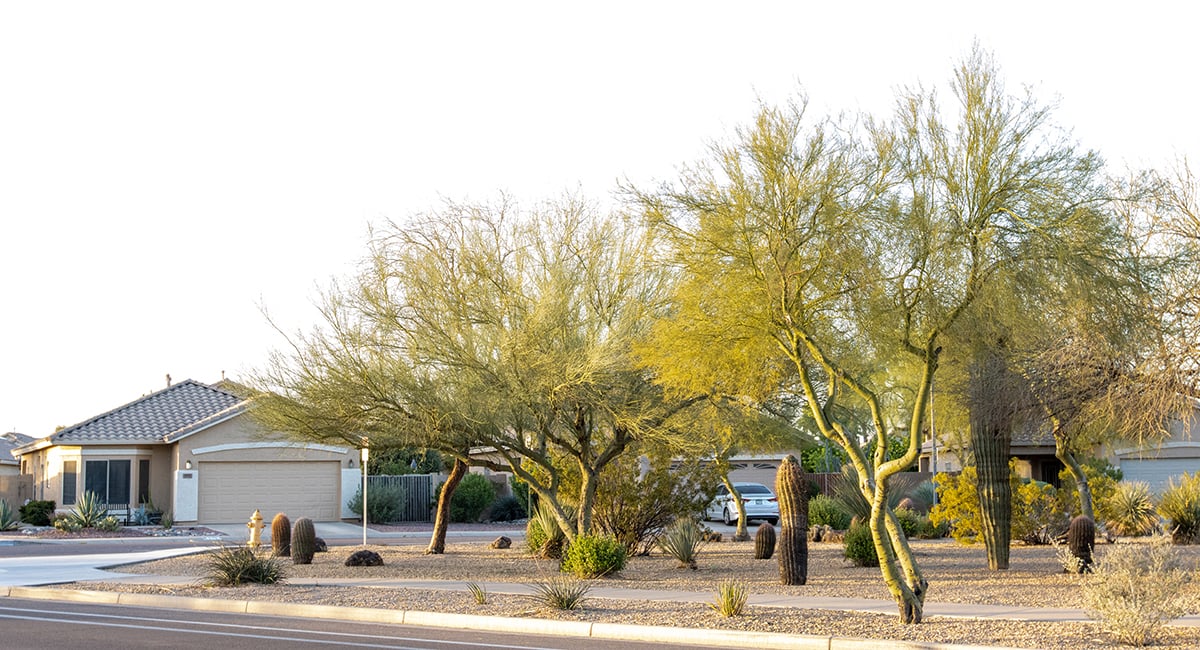
The blue palo verde is Arizona’s state tree. Several are shown in a neighborhood in North Phoenix. (Photo by Emily Mai/Cronkite News)
With names like “Trees are Cool” and a “Cool Corridor” program, Mesa and Phoenix are trying to motivate residents to join the effort by providing free trees and resources to help with planting.
The effort can’t come soon enough. Data from the National Oceanic and Atmospheric Administration suggests that Arizona’s climate conditions are becoming more extreme, and fatalities from extreme heat have spiked in recent years.
According to a report from the Arizona Department of Health Services, 835 people died from heat-caused and heat-related deaths in 2020, nearly double the 443 deaths recorded in 2019. In 2021, 302 heat-caused deaths and 552 heat-related deaths occurred for a total of 855 deaths.
Maricopa County – the fastest-growing county in the nation and home to one of the hottest cities in the U.S. in Phoenix – had a record number of 378 heat-associated deaths from Jan. 1 through Nov. 1, 2022, according to the county Public Health Department.
Nick Arnold, a legislative program manager at the climate advocacy group Climate Cabinet, said the staggering numbers aren’t a coincidence.
“We’re seeing heat and aridity increase because of climate change,” Arnold said. “Places without adequate tree coverage are experiencing worse extreme heat all throughout the day because without tree coverage, pavement and a lot of our infrastructure is absorbing heat from the Sun and then releasing it back out at night even when there is not the same solar energy.”
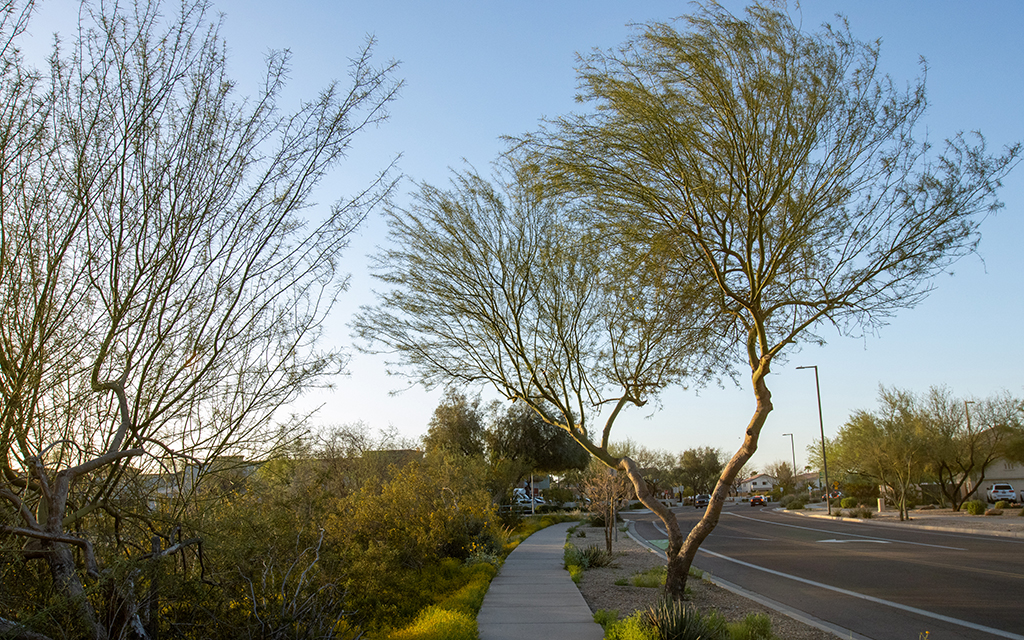

Left: Blue palo verde trees are common in the Sonoran Desert region. Photo taken in North Phoenix. Right: Arizona’s state tree, the blue palo verde, is easily recognizable due to its blue-tinged green bark and tiny leaves. Photo taken in North Phoenix. (Photos by Emily Mai/Cronkite News)
Mesa Mayor Giles announces tree-planting initiative
Seeking to increase Mesa’s tree canopy, Mayor John Giles announced a Trees are Cool initiative in February, with a goal of planting 1 million trees in the city by 2050.
“Any meaningful climate action plan … must address heat mitigation, and trees have a significant role to play in providing shade, keeping temperatures low and filtering greenhouse gas emissions,” Giles said in announcing the program. “I encourage everyone to get involved in planting new trees in Mesa.”
As part of the initiative, the mayor’s office launched an online tool to record newly planted trees. The data, which takes existing trees into account, will help the city track efforts to meet its goals. The website also shows Mesa neighborhoods at a greater risk of being impacted by the heat and provides information on choosing, planting and nurturing trees.
“We need to work together to ensure that our community can withstand the changing weather patterns caused by climate change, both in terms of extreme temperatures and ongoing drought,” Scott Bouchie, director of the Mesa Environmental and Sustainability Department, said in a news release. “It is especially important to reduce temperatures in our most vulnerable neighborhoods. And planting trees can help us do this.”
Through the city’s neighborhood planting program, Mesa residents can get up to $100 for planting two trees, according to news reports, and volunteers can help plant the trees. Find more information about the program on the city of Mesa website.

Blue palo verde trees can be spotted in neighborhoods around the Valley. Photo taken in North Phoenix. (Photo by Emily Mai/Cronkite News)
City of Phoenix gets involved
In 2021, Phoenix made headlines when it established the nation’s first publicly funded Office of Heat Response and Mitigation. Spearheaded by Arizona State University environmental science professor David Hondula, the four-person team has developed a strategic plan to combat urban heat and its associated health risks.
One of the key players on the team is Lora Martens, a landscape architect with expertise in desert plants. As the team’s urban tree program manager, Martens is tasked with increasing Phoenix’s tree canopy. Her efforts build on the city’s 2010 tree and shade master plan, which has a goal of a 25% tree canopy coverage by 2030. Martens estimates that the city only has around 12% tree canopy coverage now.
“I have a feeling that it’s close to the right goal, but that we want to maybe have more nuance in how it’s not 25% everywhere,” she said. “Maybe there should be more canopy coverage where people are walking and a little bit less in areas downtown where there’s a lot of shade from buildings.”
Martens said tree-planting efforts in Phoenix are fragmented among different city departments, with Phoenix Urban Forestry taking charge of major streets and parks. Martens’ objective is to unite all departments under a master plan for tree planting. This includes incentivizing tree planting on private properties during new construction and identifying ways to encourage planting on established sites, she said.
While the city currently conducts tree-planting events with city workers, Martens’ office is developing a program to involve volunteers. She hopes it will be operational later this year.
Phoenix currently operates a Cool Corridor Program, which combats urban heat island effects by planting trees and other vegetation along city streets. Anyone interested in getting involved in this initiative can contact the city’s Street Transportation Department for more information.

Civic Space Park trees provide shade on a warm day. Photo taken in downtown Phoenix on April 6, 2023. (Photo by Gianna Abdallah/Cronkite News)
Phoenix looks to install man-made shading too
As temperatures in Arizona continue to soar, the rising number of homeless individuals in Phoenix has contributed to the increasing number of heat facilities. According to the Maricopa Association of Governments, the number of unsheltered people in Maricopa County surged to 5,029 in January 2022 from 1,646 in 2016.
While planting more trees in the city is a long-term solution to combat the extreme heat, immediate action may be needed to provide relief to those in need. The City Council has allocated $3 million from the American Rescue Plan Act to install human-made shade structures. The Office of Heat Response and Mitigation is overseeing the project, and built environment specialist Mary Wright said that “built shade can allow us to tactically provide shade in locations where a tree likely would not survive or where a tree may require extra water to survive.”
That project is in the planning stages, she said, and community input, product availability, cost, safety and aesthetics are still being taken into account. “All of the structure designs will be customizable to incorporate the integration of local artist’s artwork, which is a high priority for the community,” she said.
The Office of Homeless Solutions is also taking steps to provide safe places for homeless individuals to cool down and access water during the hot summer months. “One of the priority areas we are targeting is putting up shade and cooling structures in and around the Human Services Campus (12th Avenue and Madison Street), where we currently have our largest concentration of people who are unsheltered. We are also continually exploring opportunities to create indoor cooling facilities,” the office said in a statement.
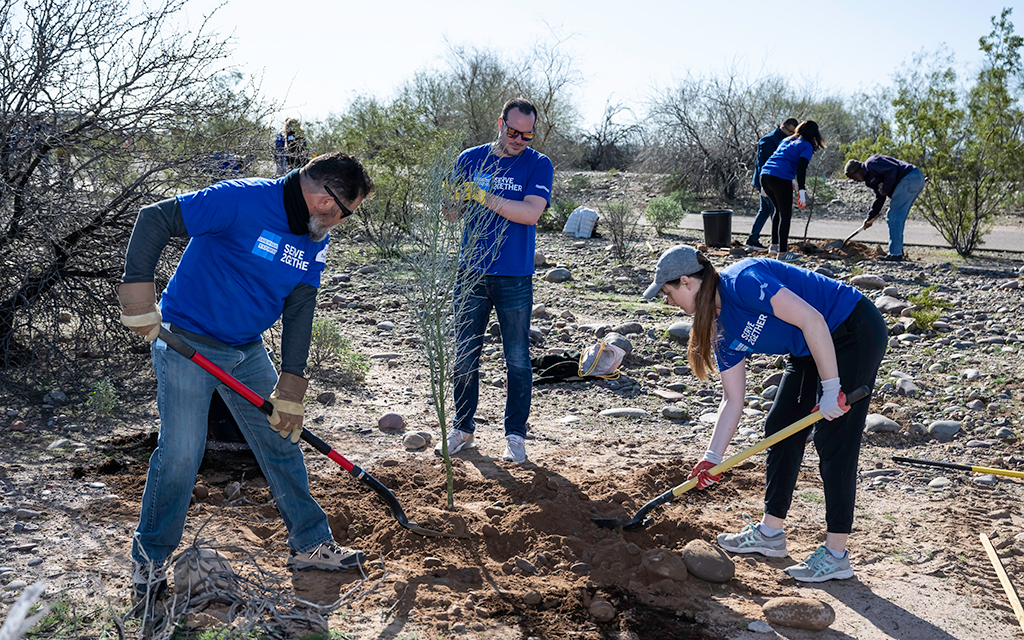
Volunteers from American Express plant trees at the Rio Salado Habitat Restoration Area in Phoenix. (Photo courtesy of American Express)
American Express and American Forests team up
Separate from Phoenix’s efforts to plant trees and install shade structures, American Express announced a $1.1 million grant to American Forests in February 2022 to help the nonprofit conservation organization increase tree equity in four cities where American Express has offices: Phoenix, New York City, Salt Lake City and Sunrise, Fla.
The two organizations are tracking progress of tree-planting efforts through an interactive map that shows the tree-equity score of neighborhoods throughout the Valley, not just Phoenix. According to American Forests’ website, the tree-equity score evaluates existing tree canopy, population density, income, employment, surface temperature, race, age and health.
American Forests calculates tree-canopy coverage in different parts of Phoenix through a partnership with EarthDefine, a geospatial data and services company based in Redmond, Wash. EarthDefine calculates coverage by targeting trees with a laser and measuring the time for reflected light to return to the receiver. Their scores are different from canopy coverage reported by Mesa and Phoenix.
Michelle Kurtz, a spokesperson for American Forests, said they use additional data from a variety of sources to derive the score, including the U.S. Census Bureau’s American Community Survey, imagery from Landsat and the Centers for Disease Control and Prevention.
American Forests has not said how many trees they expect to plant. But they indicated that their goal is to get as close as possible to a tree-equity score of 100 in each of the four cities in the grant. The grant also will support “climate-resilient urban forests, create forestry jobs marketed to historically marginalized populations, identify urban tree nursery needs and help build nursery capacity,” American Express said on its website.
According to the interactive map, Phoenix has an average tree equity of 80 out of 100. Meanwhile, Mesa has an average score of 80 and Chandler has a score of 81. Glendale and Gilbert have scores of 75 and 83, respectively.
Tree-equity scores in individual neighborhoods throughout Phoenix vary greatly. Scores are significantly lower in low-income communities and communities of color in south and west Phoenix. Some neighborhoods have scores in the 20s, 30s and 40s, while other neighborhoods in Phoenix have scores of over 90.
On Feb. 16, the partnership was kicked off when members of the American Express Phoenix office volunteered alongside representatives from American Forests and the Arizona Sustainability Alliance to plant 45 trees at the Rio Salado Habitat Restoration Area just south of downtown Phoenix. Phoenix Mayor Kate Gallego was among several community leaders in attendance.
Anyone interested in getting involved with the tree-equity program can visit the American Forests website and explore the “Get Involved” page.
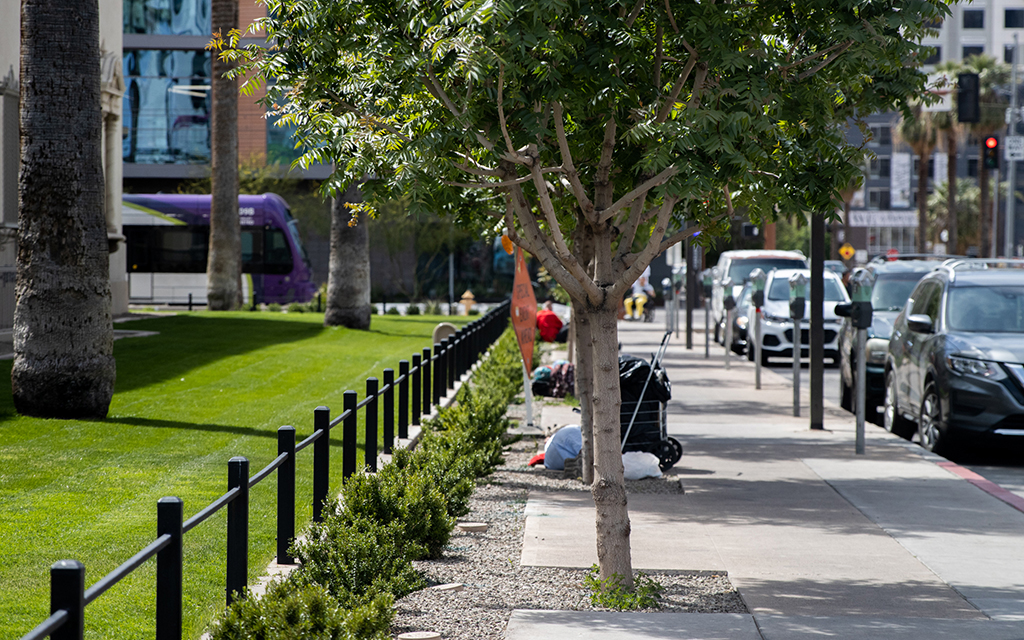
People seek shade at Civic Space Park in downtown Phoenix on April 6, 2023. (Photo by Gianna Abdallah/Cronkite News)
Trees Matter
The Phoenix nonprofit Trees Matter has worked to increase the number of trees in the Southwest since its inception in 2005.
Through its tree planting program, Trees Matter provides training tools and resources to help community members organize tree-planting events, and works with local government agencies, schools and businesses to coordinate efforts. Trees Matter also provides free trees to low-income residents and helps them plant and care for the trees.
For those looking to volunteer with Trees Matter, there are several ways to get involved. Individuals can participate in a community tree-planting event organized by the organization, become a Trees Matter ambassador, make a donation or join the organization’s mailing list to stay informed about upcoming events and volunteer opportunities.
Trees Matter’s partnership with the Salt River Project on the Utility Shade Tree Program is an example of how the organization is working with other groups to promote the benefits of trees. The program offers SRP customers a low-cost way to add shade trees around their homes and businesses, encouraging the planting of large, low-water-use shade trees that can help reduce energy consumption. Trees Matter works with SRP to provide information and resources to customers interested in participating in the program, and offers free workshops to help participants learn how to plant and care for their new trees.
Shading legislation stalls in the Legislature
While municipalities and businesses are taking action to protect citizens from the heat, the Arizona Legislature has been slow to act.
SB 1689, introduced by Sen. Mitzi Epstein, D-Phoenix, would give the Arizona Department of Education $400,000 to distribute to public schools for tree planting. Although every Senate Democrat has co-sponsored the bill, no legislative committee has taken action on it. In addition to the Senate Rules and Appropriations committees, it was assigned to the Senate Education Committee in February.
Rep. Stephanie Stahl Hamilton, D-Tucson, the ranking member on the House Natural Resources, Energy and Water Committee, said she believed that Republican lawmakers have been uncompromising on SB 1689 and other environmental justice bills proposed by Democrats.
“The Republicans have a slim majority; they are the ones in control of what bills get assigned to and heard in committee,” she said. “Unfortunately, those bills are not being discussed.”
Republicans have considered at least one bill that could increase tree equity and shading. Introduced by Rep. Gail Griffin, R-Hereford, HB 2441 would have allowed homeowners to plant Arizona’s state tree, the blue palo verde, on their property without needing a permit or being subject to fees or fines.
The bill passed the House unanimously, but a strike-through amendment in the Senate took out any mention of the state tree and instead established rules for providing water service to communities outside a city or town water service area relating to the Rio Verde Foothills community near Scottsdale.

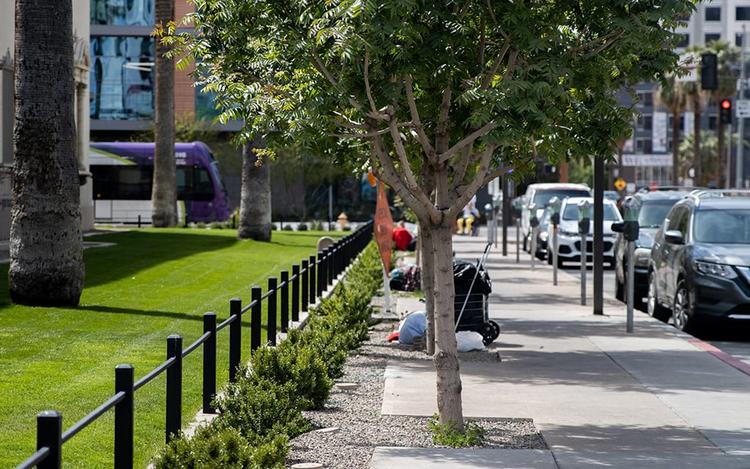
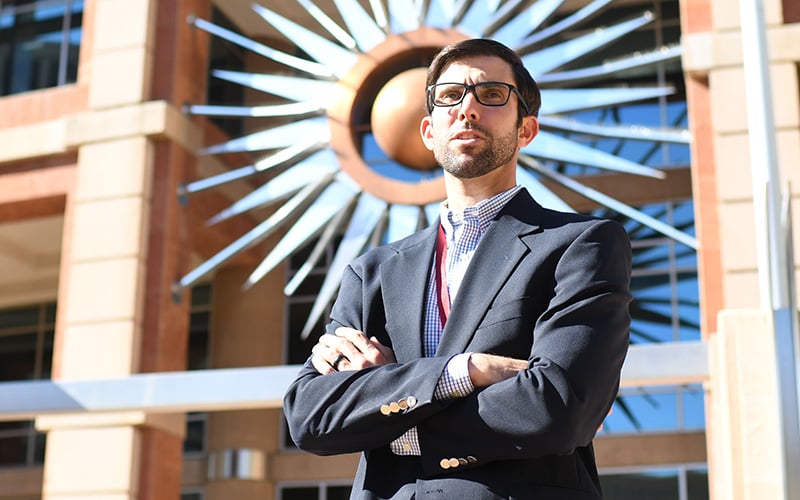
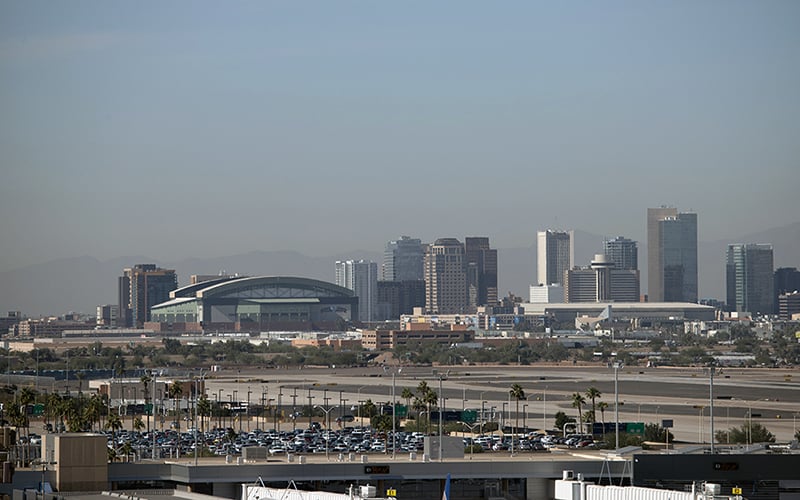




 © 2025 All Rights Reserved
© 2025 All Rights Reserved